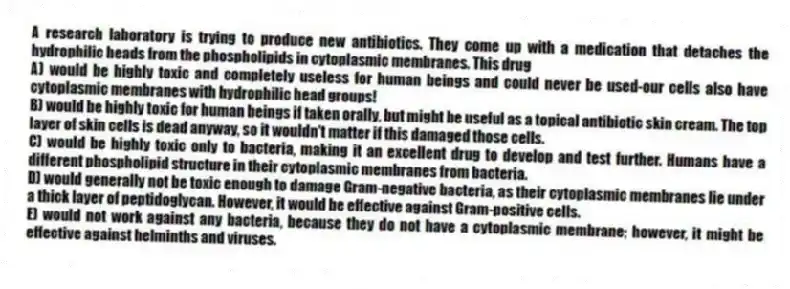
A research laboratory is trying to produce new antibiotics. They come up with a medication that detaches the hydrophilic heads from the phospholipids in cytoplasmic membranes. This drug
A) would be highly toxic and completely useless for human beings and could never be used-our cells also have cytoplasmic membranes with hydrophilic head groups!
B) would be highly toxic for human beings if taken orally, but might be useful as a topical antibiotic skin cream. The top layer of skin cells is dead anyway, so it wouldn't matter if this damaged those cells.
C) would be highly toxic only to bacteria, making it an excellent drug to develop and test further. Humans have a different phospholipid structure in their cytoplasmic membranes from bacteria.
D) would generally not be toxic enough to damage Gram-negative bacteria, as their cytoplasmic membranes lie under a thick layer of peptidoglycan. However, it would be effective against Gram-positive cells.
E) would not work against any bacteria, because they do not have a cytoplasmic membrane; however, it might be effective against helminths and viruses.
Correct Answer:
Verified
Q64: Prokaryotes may ingest particles via phagocytosis.
Q65: A research laboratory is investigating environmental factors
Q66: Mitochondria and chloroplasts are thought to have
Q67: You want to examine the structure of
Q68: The lab report also details the results
Q70: A newly developed antibiotic drug shows promise
Q71: A new drug is developed that inhibits
Q72: Cilia and flagella project from the cell
Q73: You perform a rapid strep test on
Q74: As she is preparing to leave your
Unlock this Answer For Free Now!
View this answer and more for free by performing one of the following actions

Scan the QR code to install the App and get 2 free unlocks

Unlock quizzes for free by uploading documents